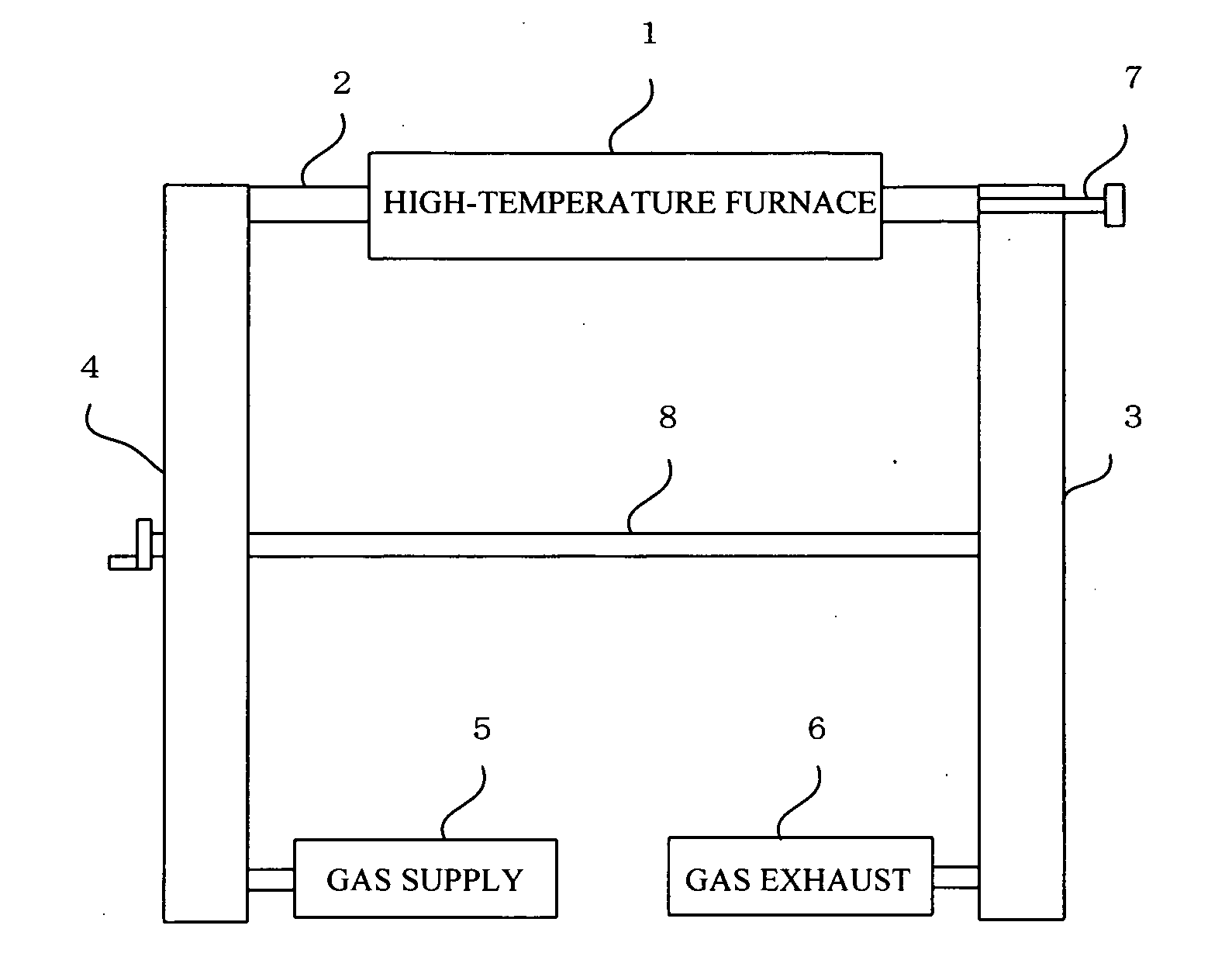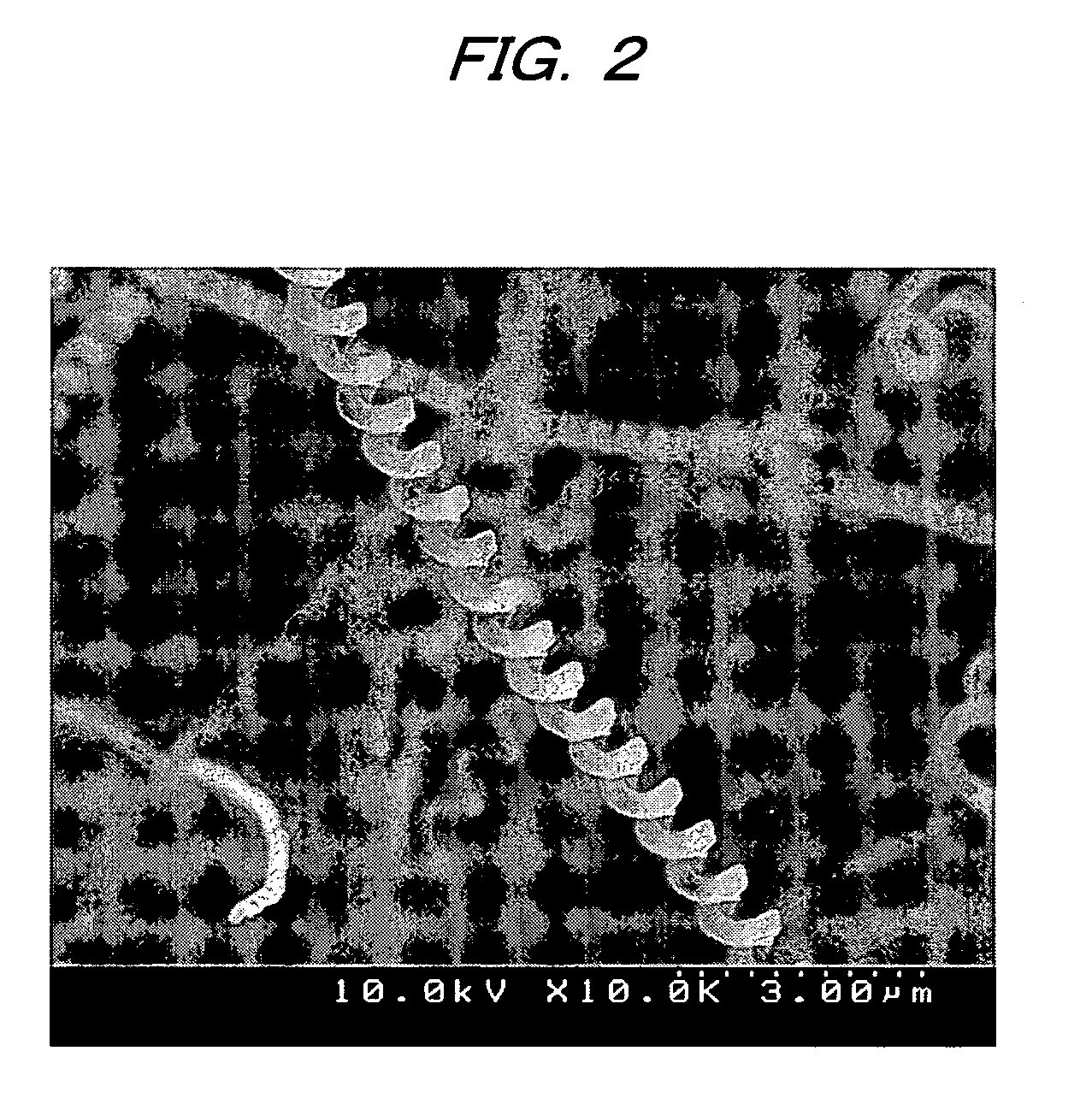Continuous-atmosphere high-temperature furnace apparatus, method of continuous production of nanocarbon, and method of burning and graphitizing nano-material
a high-temperature furnace and atmosphere technology, applied in lighting and heating apparatus, furnace types, furnaces, etc., can solve the problems of inconvenient use, inconvenient control of atmosphere, and inability to meet the requirements of ultra-high-temperature ranges, so as to achieve dramatic improvement of work efficiency and reduce heating and cooling time
- Summary
- Abstract
- Description
- Claims
- Application Information
AI Technical Summary
Benefits of technology
Problems solved by technology
Method used
Image
Examples
embodiment 1
[0032]In Embodiment 1, the delivery mechanism 3 and discharge mechanism 4 are arranged as horizontally disposed belt conveyors in the same manner as the schematic diagram shown in FIG. 1. The belt conveyors are intermittently moved using a stepping motor. The insertion mechanism 7 uses a sliding rod mounted in a Wilson seal.
[0033]A mixture of iron and tin powders as a catalyst was uniformly coated onto a silicon substrate, the substrate was secured facing upward in a graphite crucible, and the crucible was placed on the conveyor of the delivery mechanism 3 from the high-temperature area.
[0034]A vacuum was formed by a vacuum pump of the gas exhaust section 6 to exhaust air from the heat-resistant tube 2, and nitrogen gas was introduced via the gas supply section 5 to the heat-resistant tube 2. These steps were carried out twice and ventilation was performed. A vacuum was formed by the vacuum pump of the gas exhaust section 6 to exhaust the nitrogen gas from the heat-resistant tube 2,...
embodiment 2
[0041]The apparatus used in Embodiment 2 was the same as in the schematic diagram shown in FIG. 1. However, the delivery mechanism 3 and discharge mechanism 4 were vertically disposed lift conveyors. The lift conveyors were intermittently moved using a stepping motor. The insertion mechanism 7 used a sliding rod mounted in a Wilson seal.
[0042]Nanocarbon produced by chemical vapor deposition (CVD) process was placed in a graphite crucible, and the crucible was placed on the conveyor of the delivery mechanism 3 from the high-temperature area.
[0043]A vacuum was formed by a vacuum pump of the gas exhaust section 6 to exhaust air from the heat-resistant tube 2, and nitrogen gas was introduced via the gas supply section 5 to the heat-resistant tube 2. These steps were carried out twice and ventilation was performed. A vacuum was formed by the vacuum pump of the gas exhaust section 6 to exhaust the nitrogen gas from the heat-resistant tube 2, and argon gas was introduced via the gas supply...
embodiment 3
[0048]The same apparatus as in Embodiment 2 was used in Embodiment 3.
[0049]Nanocarbon produced in the manner described above was placed in a graphite crucible, and the crucible was placed on the conveyor of the delivery mechanism 3 from the high-temperature area.
[0050]A vacuum was formed by a vacuum pump of the gas exhaust section 6 to exhaust air from the heat-resistant tube 2, and nitrogen gas was introduced via the gas supply section 5 to the heat-resistant tube 2. These steps were carried out twice and ventilation was performed. A vacuum was formed by the vacuum pump of the gas exhaust section 6 to exhaust the nitrogen gas from the heat-resistant tube 2, and argon gas was introduced via the gas supply section 5 to the heat-resistant tube 2.
[0051]While argon gas was introduced via the gas supply section 5, the temperature of the heat-resistant tube 2 was increased to 2800° C., and the temperature control apparatus provided to the high-temperature furnace 1 was used to automatical...
PUM
 Login to View More
Login to View More Abstract
Description
Claims
Application Information
 Login to View More
Login to View More - R&D
- Intellectual Property
- Life Sciences
- Materials
- Tech Scout
- Unparalleled Data Quality
- Higher Quality Content
- 60% Fewer Hallucinations
Browse by: Latest US Patents, China's latest patents, Technical Efficacy Thesaurus, Application Domain, Technology Topic, Popular Technical Reports.
© 2025 PatSnap. All rights reserved.Legal|Privacy policy|Modern Slavery Act Transparency Statement|Sitemap|About US| Contact US: help@patsnap.com



